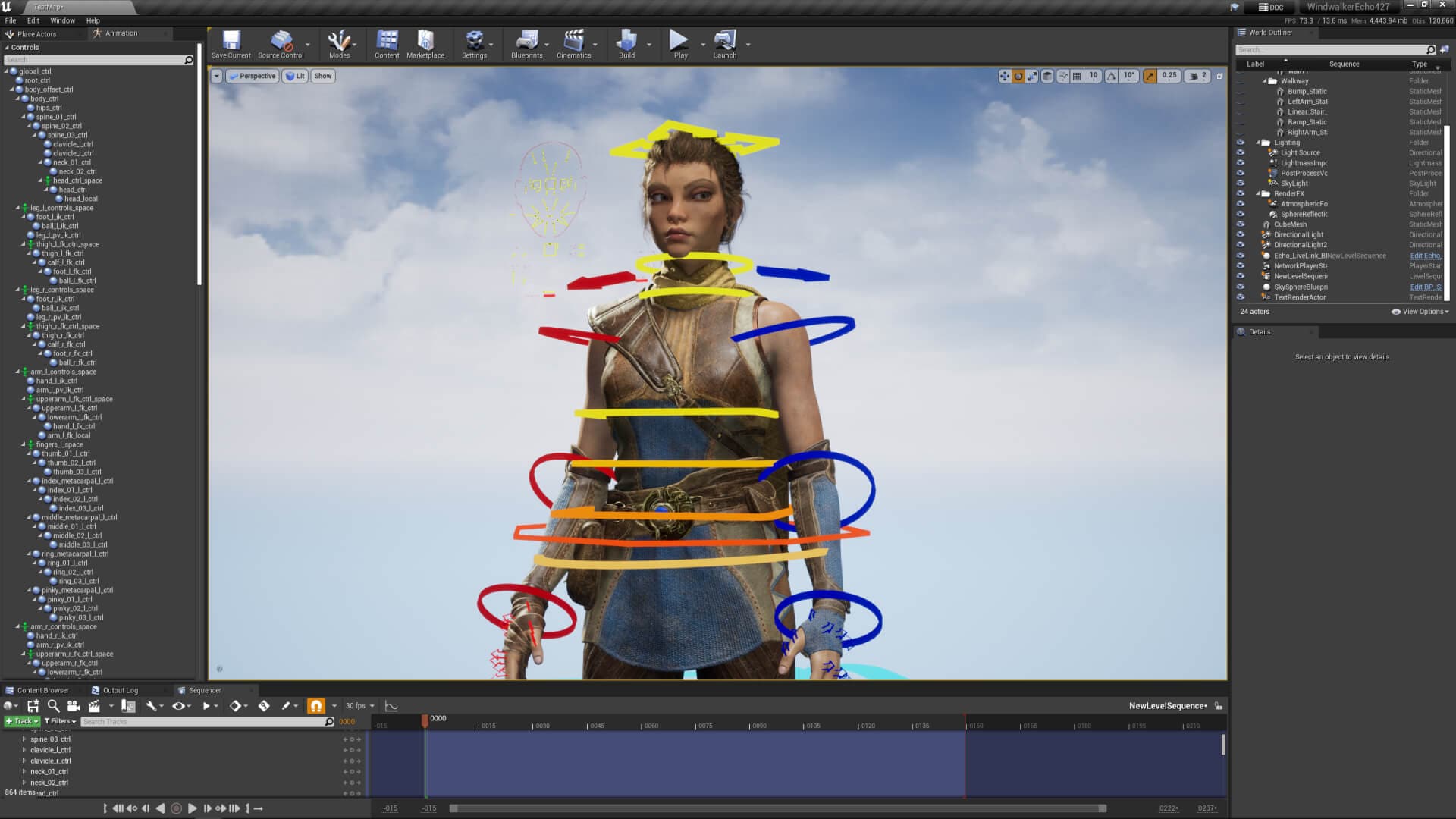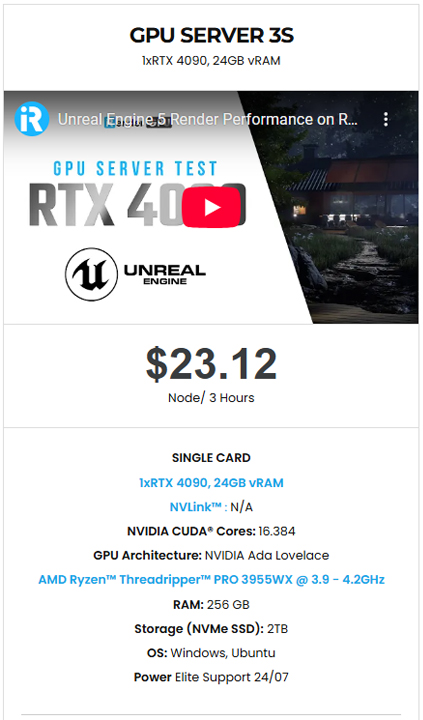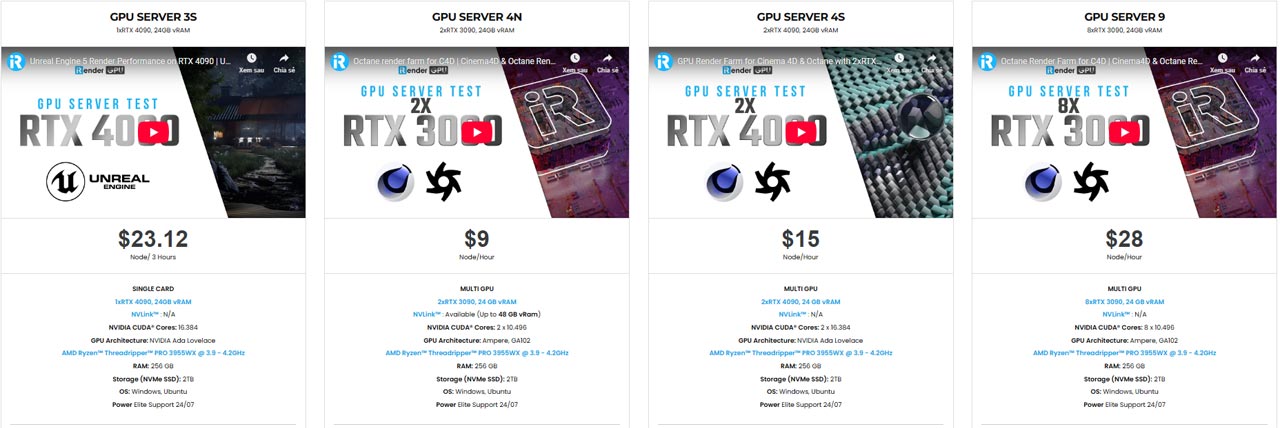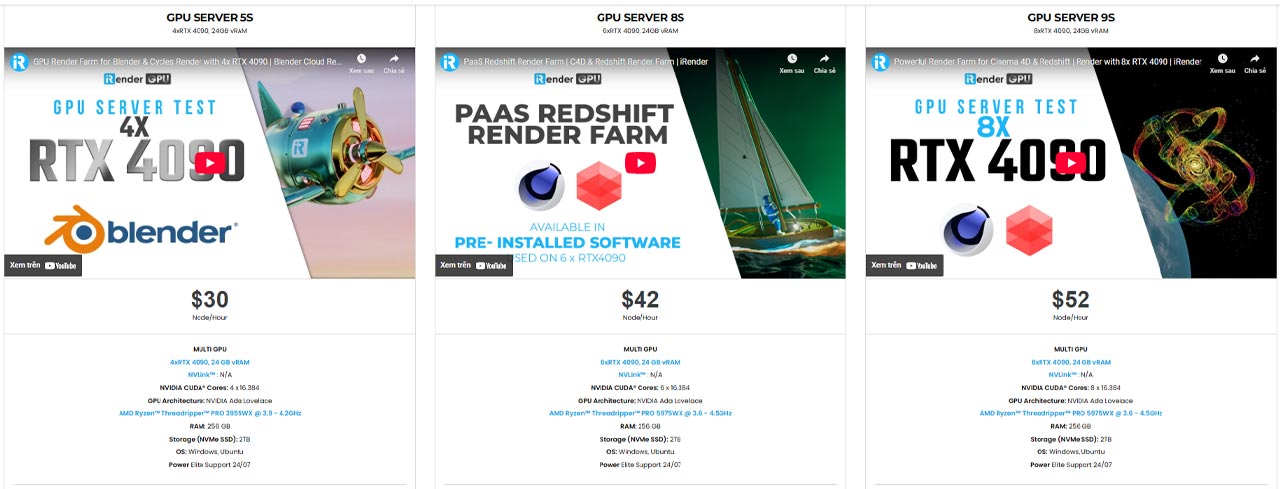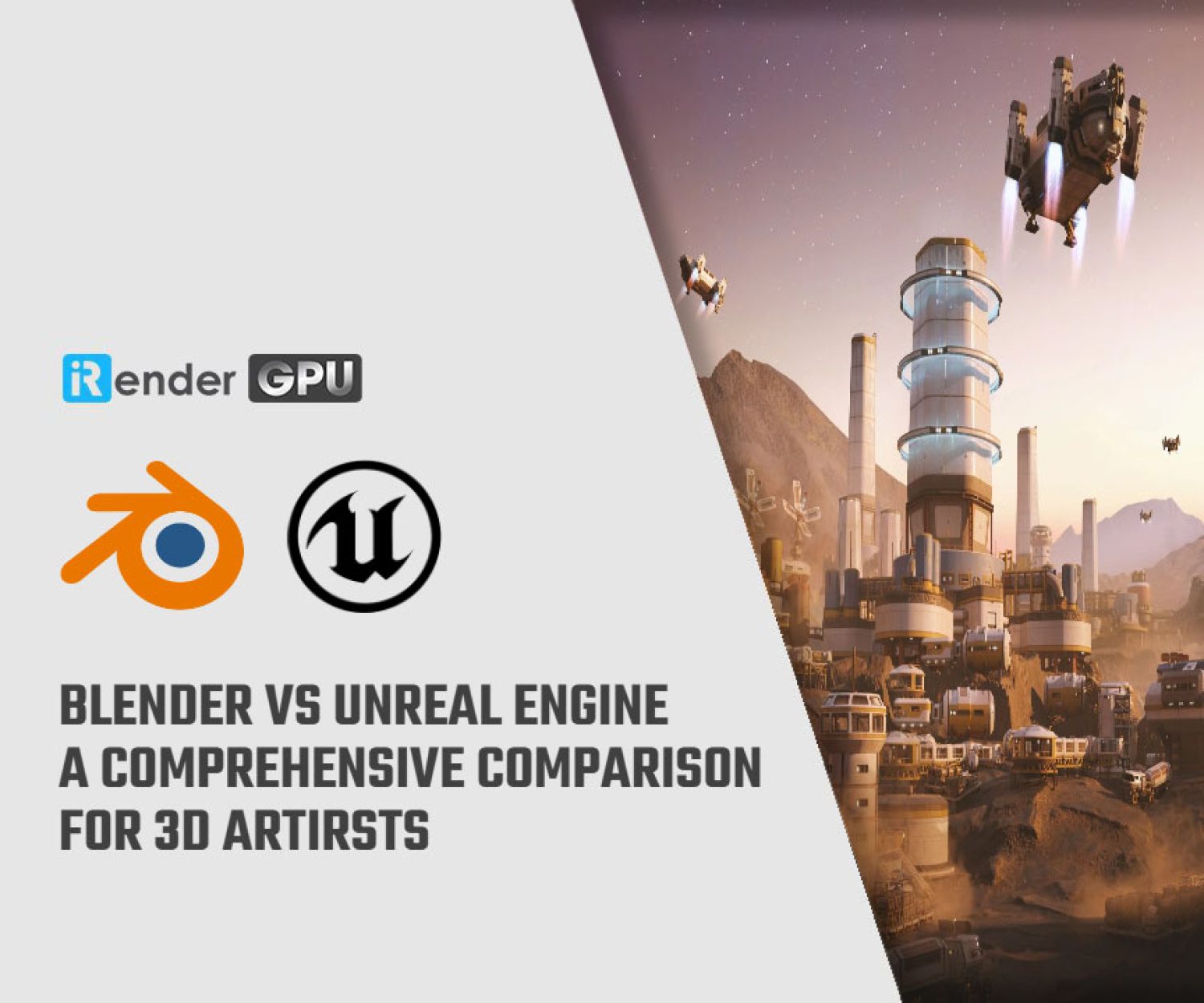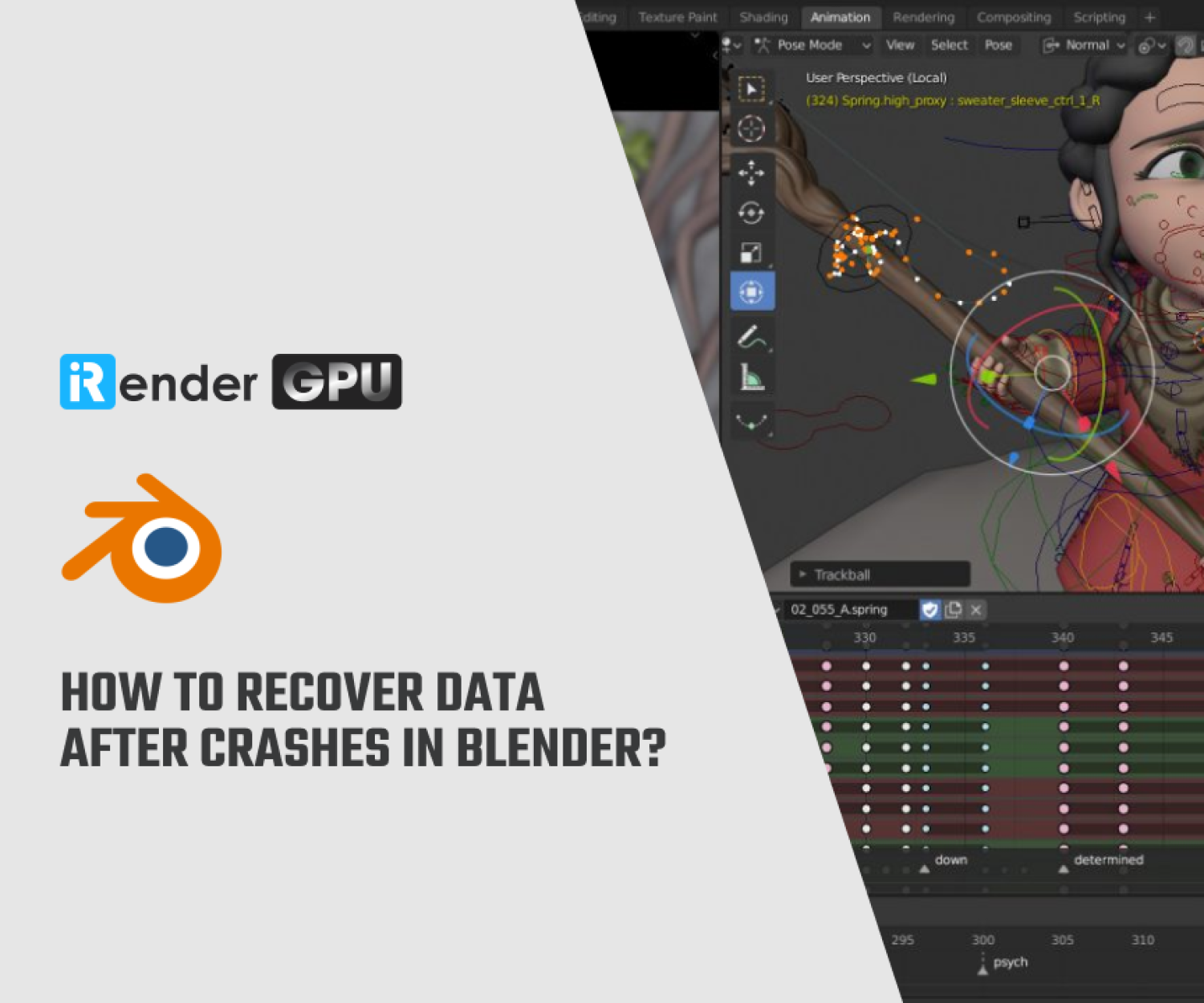Blender vs Unreal Engine: A Comprehensive Comparison for 3D Artists
In the ever-evolving landscape of digital creation, two names consistently stand out: Blender and Unreal Engine. Each represents the pinnacle of innovation in its domain: Blender, a powerful, open-source 3D creation suite trusted by artists worldwide, and Unreal Engine, a real-time graphics powerhouse driving some of the most breathtaking interactive experiences in modern media. As the boundaries between film, gaming, and virtual production blur, understanding the unique advantages of Blender and Unreal Engine will empower you to make informed decisions for your creative projects..
In this comparative blog, iRender will explore Blender vs Unreal Engine, examining key aspects such as modeling, animation, rendering, and user experience.
Overview and Purpose of Blender and Unreal Engine
Blender
Blender is a free and open-source 3D modeling and animation software that has gained immense popularity within the 3D community. With a robust set of features including modeling, animation, sculpting, texturing, and rendering, Blender is suitable for a variety of creative projects ranging from indie game development to professional animations. The primary purpose of Blender is to empower users to create 3D content without financial barriers, democratizing access to powerful tools typically reserved for larger studios. Blender serves a multitude of applications, including:
- 3D Modeling: Artists can create intricate models from scratch or modify existing ones using a variety of modeling techniques, including polygon modeling and sculpting.
- Animation: Blender supports full character rigging, keyframe animation, and simulation, making it suitable for creating professional-quality animations and visual effects.
- Rendering: With engines like Eevee for real-time rendering and Cycles for ray-traced output, Blender provides options for both fast previews and high-quality final renders.
- Game Asset Creation: Blender is frequently used to create assets for games, which can then be exported to other engines like Unreal Engine.
Unreal Engine
Unreal Engine, developed by Epic Games, is a powerful game engine known primarily for its exceptional graphics rendering capabilities and versatility in creating immersive interactive environments. It is widely used in the gaming industry and is also increasingly adopted for architectural visualization, virtual cinematography, and other applications. The primary purpose of Unreal Engine is to provide developers with the tools and resources needed to build sophisticated, high-performance games and interactive projects.
- Game Development: Unreal Engine excels in creating high-quality, visually stunning games, complete with intricate physics systems, AI, and complex gameplay mechanics.
- Virtual Reality and Augmented Reality: The engine’s ability to render high-fidelity visuals in real time makes it ideal for VR and AR applications, enhancing user immersion and interactivity.
- Architectural Visualization: Unreal Engine is used to create photorealistic architectural renderings and interactive walkthroughs, enabling clients to experience designs before they are built.
- Film and Animation: With tools for virtual cinematography and the ability to integrate live-action footage, Unreal Engine is increasingly adopted for film production, allowing for innovative storytelling techniques.
Features Comparison
Modeling and Sculpting
Blender offers a wide range of modeling tools such as sculpting, mesh editing, and UV mapping. It has a very flexible interface, allowing for detailed model creation. Blender’s sculpting tools facilitate the creation of high-resolution, intricate details. Artists can work with various brush settings, symmetry options, and dynamic topology to enhance their sculpts. The versatility of Blender makes it suitable for both hard surface modeling and organic shapes, catering to a wide range of artistic styles.
Unreal Engine is primarily an engine for rendering and interacting with models rather than creating them. Models are typically created in Blender or other dedicated software before being imported into Unreal Engine. It offers a wide-ranging set of modeling tools, including mesh modeling, sculpting, and retopology. Tools like Subdivision Surface, Boolean, and Array modifiers can be applied non-destructively, providing powerful options for complex modeling tasks.
Animation and Rigging
Blender supports traditional keyframing, allowing artists to define specific poses or states for objects, characters, or cameras at different points in time. The timeline and graph editor provide robust controls for editing keyframes and fine-tuning animations. Blender serves as a comprehensive solution for animation and rigging, offering a wide array of tools for character animation, keyframing, shape keys, and rigging systems. Its extensive feature set makes it ideal for detailed animation projects, allowing artists to create high-quality animations from start to finish.
On the other hand, Unreal Engine is designed to implement and manage animations within an interactive context. It excels in providing tools for animation control, blending, and state management, making it well-suited for real-time applications. While Unreal does have some basic rigging capabilities through features like Control Rig, rigging itself is typically performed in Blender or other dedicated applications first.
Rendering
Blender features two main rendering engines: Cycles and Eevee.
- Cycles is a ray-tracing engine known for its high photorealistic rendering capabilities, making it well-suited for animations and stills that demand accurate light simulation and material representation. With Cycles, Blender can achieve incredibly high-quality visuals that are suitable for film and animation. It excels in achieving realistic textures, complex shading, and detailed environmental effects.
- Eevee, on the other hand, is a real-time rendering engine that provides faster render times with good visual quality, designed for quick previews and less resource-intensive projects. The Eevee engine, while faster, sacrifices some photorealism in favor of speed, making it best for projects where real-time feedback is necessary rather than perfect accuracy.
Unreal Engine is primarily designed for real-time rendering, which allows for dynamic lighting, shadows, and reflections. Real-time rendering allows for instantaneous feedback without the lengthy render times associated with traditional rendering engines. This is particularly advantageous in game development and interactive media where immediate visual response is crucial. It employs technologies like Lumen and Nanite in Unreal Engine 5.
- Lumen provides real-time global illumination and reflections, dramatically improving the realism of lighting in dynamic environments.
- Nanite allows for higher polygon counts without compromising performance, enabling the rendering of extremely detailed environments in real-time.
Real-time capabilities
Blender utilizes Eevee as its real-time rendering engine. It is designed for speed and efficiency, providing instant feedback on scene changes. Key features include screen-space reflections, volumetric lighting, and baked data support, which enhances the rendering quality while maintaining performance. Blender’s viewport offers a powerful real-time preview system, allowing artists to see adjustments immediately as they edit their models and scenes, making it easier to visualize materials, lighting, and composition quickly.
Unreal Engine is inherently built for real-time applications. It leverages advanced technologies like Lumen (for dynamic global illumination and reflections) and Nanite (for handling high-detail assets at real-time frame rates) to achieve superior visual fidelity while maintaining responsiveness. This makes it ideal for interactive environments, games, and virtual productions. Unreal Engine offers a visual scripting system (Blueprints) that allows developers to create complex interactions and gameplay logic without deep programming knowledge, facilitating the creation of interactive real-time experiences.
Let’s look at a comparison table for better understanding following:
| Feature | Blender | Unreal Engine |
| Rendering technology | Eevee for real-time rendering | Real-time rendering with Lumen and Nanite |
| Real-time performance | Fast rendering suitable for quick previews | Optimized for high-performance real-time rendering |
| Quality of Output | Good quality, but sacrifices some realism for speed | High-quality visuals comparable to offline rendering |
| Dynamic Lighting | Supports screen-space reflections and basic dynamic lighting | Advanced dynamic global illumination with Lumen |
| Viewport Feedback | Instant feedback in the viewport | Full interactivity with complex gameplay logic |
| Use Cases | Best for asset creation, animations, and VFX | Ideal for games, simulations, and interactive media |
Should I learn Blender or Unreal Engine ?
Whether you should learn Blender or Unreal Engine first depends on your goals. In general, Blender is the better starting point for most 3D artists. Blender is a comprehensive, beginner-friendly, and free 3D creation suite that covers modeling, sculpting, texturing, animation, and basic rendering. Learning Blender first helps you build a solid foundation in 3D design principles and asset creation—skills that are transferable to any 3D pipeline, including Unreal Engine.
On the other hand, Unreal Engine is a powerful real-time engine primarily used for game development, interactive media, and high-end visualizations. It excels at environment creation, lighting, VFX, and rendering large-scale scenes in real time. However, Unreal often relies on importing assets made in software like Blender. Therefore, by mastering Blender first, you’ll be able to create custom content to bring into Unreal later. Once you’re comfortable with 3D basics and asset creation in Blender, transitioning to Unreal Engine will feel much smoother and more intuitive.
Conclusion
All in all, both Blender and Unreal Engine offer unique strengths for 3D artists, making them invaluable tools in the creative toolkit. Blender excels in 3D modeling, animation, and visual effects, making it ideal for artists focused on asset creation and non-interactive media. On the other hand, Unreal Engine shines in real-time rendering and interactive experiences, making it a go-to choice for game development and immersive simulations. Ultimately, the best choice depends on your specific goals and projects; many artists benefit from leveraging both platforms to create stunning, engaging content that merges artistry with technology.
iRender- The best render farm supports Blender and Unreal Engine
iRender is proud to be one of the best GPU service providers on the market. You can find a lot of options suitable for your Blender project. iRender offers from 1/2/4/6/8 RTX 4090s and 3090s. In addition to offering powerful configurations, all servers at iRender are also equipped with AMD Ryzen™ Threadripper™ PRO 3955WX @ 3.9 – 4.2GHz or AMD Ryzen™ Threadripper™ PRO 5975WX @ 3.6 – 4.5GHz, 256GB RAM, 2TB Storage NVMe SSD.
We have many server packages, from single GPU to multiple GPUs. For real-time rendering software like Unreal Engine, we suggest our server 3S with the high-end hardware such as CPU AMD Ryzen Threadripper Pro 3955WX at 3.9GHz clock speed, core 16, thread 32. RAM 256GB Storage NVMe SSD 2TB and Video card RTX4090.
You can see our 3S servers’ configuration following:
For modeling like Blender, we suggest you use servers multi cards RTX 4090 for speeding up your render. We provide 1/2/4/6/8 RTX 4090 servers, you can see all servers below:
Let’s see how our RTX4090 performs when rendering with Blender scenes:
Why Choose iRender?
At iRender, we pride ourselves on providing unparalleled cloud rendering services designed to enhance your creative workflow. With our high-end GPU configurations, user-friendly interface, and dedicated support, it’s easier than ever to achieve stunning results.
- IaaS Infrastructure – Full Control & Customization
- GPU Power- RTX 4090/3090
- Outstanding Support
- Affordable Price
This month, we are running a SPECIAL OFFER: 100% Additional Bonus for new clients who register an account and make a top-up within 24 hours after their registration.
Register an account today to experience our service or contact us via email at [email protected] or WhatsApp: at (+84) 912075500 for advice and support.
iRender – Happy Rendering!
Related Posts
The latest creative news from Blender Cloud Rendering.



